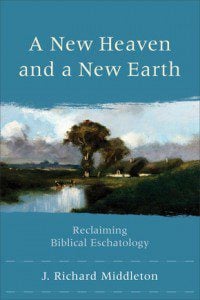 As Christians we love to sing. This is an important and beautiful part of worship. But the words to these song teach theology … and the theology isn’t always right. One place where our song may take us wrong is in our vision of Christian hope. Do we hope for “a home beyond the skies”… “when earthly things are past” … where “on heaven’s blissful shore” … “forever may we sing Alleluias to our King?” A hodgepodge of lines from a number of songs.
As Christians we love to sing. This is an important and beautiful part of worship. But the words to these song teach theology … and the theology isn’t always right. One place where our song may take us wrong is in our vision of Christian hope. Do we hope for “a home beyond the skies”… “when earthly things are past” … where “on heaven’s blissful shore” … “forever may we sing Alleluias to our King?” A hodgepodge of lines from a number of songs.
Last year I read through and posted on J. Richard Middleton’s fascinating book The Liberating Image: The Imago Dei in Genesis 1, learning much in the process. Late last year Middleton published a new book: A New Heaven and a New Earth: Reclaiming Biblical Eschatology. This book’s been in my “to read” pile ever since, finally making it to the top.
The introduction sets the stage for the rest of the book. (And includes a section on singing lies in church.)
In Matthew 19 we find the story of the rich young man who came to Jesus asking how he could receive eternal life. When Jesus responded “go, sell your possessions and give to the poor… then come, follow me” the (very) rich young man went away sad. Following this Peter asks “We have left everything to follow you! What then will there be for us?” and Jesus responds:
Truly I tell you, at the renewal of all things, … everyone who has left houses or brothers or sisters or father or mother or wife or children or fields for my sake will receive a hundred times as much and will inherit eternal life. But many who are first will be last, and many who are last will be first.
The phrase “at the renewal of all things” presents a key idea that is often overlooked in Christian ideas about the age to come. We look forward to a bodily resurrection and a renewed and consummated creation.
In a section titled “The Bible’s Best-Kept Secret” Middleton writes:
Central to the way the New Testament conceives the final destiny of the world is Jesus’ proclamation in Matthew 19:28 of a “regeneration” (KJV, NASB) that is coming; Matthew here uses the Greek word palingenesia, which both the NIV and NRSV translate as “the renewal of all things,” correctly getting at the sense of cosmic expectation in Jesus’s prediction. Likewise we have Peter’s proclamation of the “restoration [apokatastasis] of all things” (Acts 3:21), which does in fact contain the Greek for “all things” (panta). When we turn to the Epistles, we find God intent to reconcile “all things” to himself through Christ articulated in Colossians 1:20 while Ephesians 1:10 speaks of God’s desire to unify or bring together “all things” in Christ. (p. 24)
In context “all things” includes both things in heaven and things on earth; that is everything created in Genesis 1 is renewed and reconciled. “This holistic vision of God’s intent to renew or redeem creation is perhaps the Bible’s best kept secret.” (p. 24)
The holistic vision running through the New Testament has its roots in the Old Testament. There is little to no emphasis on an “afterlife” in the Old Testament. This wasn’t part of the ancient Israelite expectation. The phrase a new heaven and a new earth used in Revelation 21:1 and 2 Peter 3:13 comes from Isaiah 65 and 66. In Isaiah it looks quite clearly to a redeemed and flourishing Jerusalem and Israel, but still a mortal existence: for one who dies at a hundred years will be considered a youth, and one who falls short of a hundred will be considered accursed. Flourishing until old age, but ultimately death comes to all. In fact: “The Old Testament does not spiritualize salvation, but rather understands it as God’s deliverance of people and land from all that destroys life and the consequent restoration of people and land to flourishing.” (p. 25)
Middleton notes that there is a shift in later Old Testament texts toward a positive afterlife, and a resurrection, when death will be swallowed up and tears wiped away (primarily Isaiah, Ezekiel, and Daniel), but this is still associated with ruling on earth not some other-worldly existence. In Jewish expectation resurrection “fulfills the original human dignity and status in Genesis 1:26-28 and Psalm 8:4-8, where humans are granted rule of the earth.” (p. 26)
The New Testament vision of a renewal of all things with a new creation, a new heaven and a new earth, builds on this Old Testament foundation of a material restoration to flourishing.
The inner logic of this vision of holistic salvation is that the creator has not given up on creation and is working to salvage and restore the world (human and nonhuman) to the fullness of shalom and flourishing intended from the beginning. And redeemed human beings, renewed in God’s image, are to work toward and embody this vision in their daily lives. (p. 27)
There are historical reasons why the common view of some other-worldly “heaven” as our final destination is so common in the church. Middleton runs through a little of this history in this introductory chapter, beginning with the influence of Greek philosophy on some early church fathers. But the purpose of the book isn’t to analyze the history of Christian thought, rather the purpose is to develop a genuinely biblical view of holistic salvation. In the remainder of the book Middleton presents his argument in detail. In the weeks to come we will work through this argument with Middleton, looking first at each of the main points – the plot of the biblical story (including human vocation), holistic salvation in the Old Testament, and the New Testament’s vision of cosmic renewal. Having put forth the argument Middleton finishes the book by considering potential problem texts for his argument of a holistic view of renewal and, finally, the ethical implications of the Kingdom. Whether we agree or disagree in the end, it should be a good journey.
How do you think about the end of the age?
What is the Christian hope?
What is the new heavens and the new earth?
If you wish to contact me directly you may do so at rjs4mail [at] att.net.
If interested you can subscribe to a full text feed of my posts at Musings on Science and Theology.















